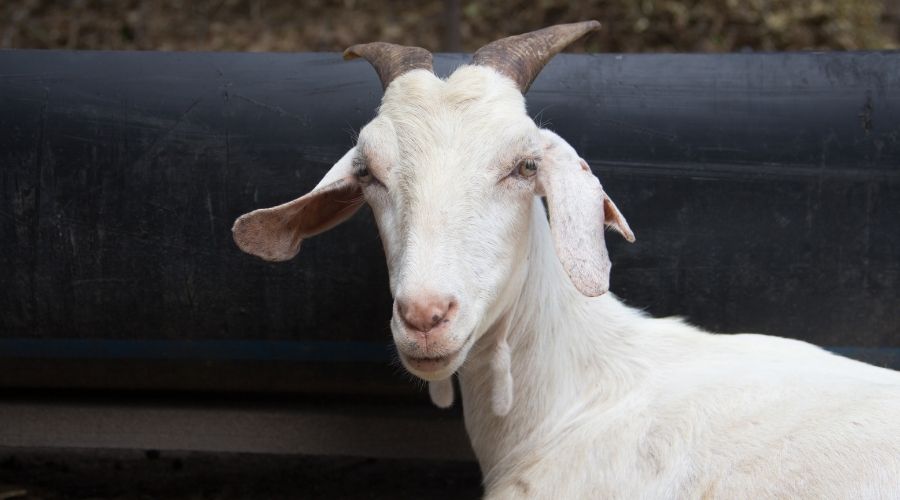Goats aren’t as famous as turkeys are for their wattles, but they grow them nonetheless. Goats, along with many bids, red wattle pigs, and other animals, can all have wattles.
However, in humans, a wattle is less of a protrusion than a description of loose or fatty skin. Why do goats have wattles?
Goats have wattles because they evolved them as a container for an organ that they lack now. Wattles are skin appendages that are evolutionary remnants of a gland that is no longer needed or required by the body of the goat. They serve no purpose and not all goats have wattles.
Table of Contents
Why Do Some Goats Have Wattles
Wattles on goats are a genetic throwback to an organ the goats no longer use or need. However, the gene to produce the wattles is present in some goat’s lineage.
As a result, a baby that gets the coding for wattles in their DNA from both parents will develop wattles.
Wattles are like eye or hair color. They are part of the genetic inheritance of the individual animal. However, some goats whose parents have no apparent wattles can still end up with them when the trait skips a generation.
Are Goats Born With Wattles
Not all goats have wattles. However, those that do are born with them. The fleshy protrusions will grow in size along with the goat, but babies with this dominant gene will have them at birth rather than growing them later like horns.
Goat breeders and enthusiasts often favor those born with wattles, calling them ‘goat jewelry.’ The little bits of extra skin are seen as desirable and thought of as ‘cute’ accessories.
Purpose Of Wattles On Goats
Wattles serve no current purpose on goats. They are not a helpful sexual trait for display or mating, and they don’t perform any other known function, which is odd but not unheard of.
Just as some snakes have the pelvis and bones of a creature that is still devolving an unneeded body part, some goats, sheep, cattle, and other animals have wattles.
The two most common theories are that they are either the remnants of gills or another organ. The remaining skin isn’t something the goat can use, whatever the original case. In birds like turkeys, the wattle is very different.
Audubon says that for avians, the “… wattle helps release excess heat. Birds don’t sweat—they can’t sweat—so the turkey is otherwise trapped in its dense, dark feathers… When the male turkey gets to courting the hens, the wattle takes center stage. Extra blood rushes in, and the wattle glows bright scarlet for maximum visual impact.”
Unfortunately, the wattles of mammas like goats are not like bird wattles.
Are Wattles On Goats Bad
The wattles on goats serve no purpose at all. Sadly, because they are fleshy protrusions, some people who don’t know much about goats will assume they may be infections, cysts, or cancers, which they are not.
Wattles are not bad for goats. They are natural, not painful, and they are supposed to be there.
Wattles can make goats more desirable and marketable. Because people see wattles as a visually desirable addition that adds appeal, these goats are more likely to be purchased.
What Type Of Goats Have Wattles
Wattles are common on numerous types of goats. Most dairy goats can develop wattles, but it is also notably more common in Swiss goat breeds. Non-dairy goats like those found in the wild are less likely to have wattles.
Do Kiko Goats Have Wattles
Kiko goats were first developed in New Zealand, where they were seeking to create an indigenous species with more muscle.
Kikos can have wattles, but like all wattle-goats, they need the coding from both parents since wattles are heterozygous.
According to Genome.gov, “Heterozygous refers to having inherited different forms of a particular gene from each parent. A heterozygous genotype stands in contrast to a homozygous genotype, where an individual inherits identical forms of a particular gene from each parent.”
Do Pygmy Goats Have Wattles
Pygmy goats are one of the most common breeds to have wattles. These adorable miniature goats are also known as Cameroon Dwarf Goats because they come from the French Cameroon area in West Africa.
Notably, not all dwarf goats are pygmies, and only this breed is known for a higher instance of wattles.
Do Female Goats Have Wattles
Much like their beards, goats of both genders can have wattles. Female goats are no more or less likely to have wattles. Additionally, the number and placement of the individual goat’s wattles have nothing to do with their gender.
Even though wattles are sometimes compared to testees, they are unrelated to sexual characteristics and not used for mating displays.
A female goat gets her wattles the same way a male would. Gender notwithstanding, if both of the goat’s parents have the gene for wattles, they get them because it’s a dominant gene.
Do Boer Goats Have Wattles
Along with pygmies, the Boer goats have the greatest likelihood of wattles. This breed is often crossed with dairy goats.
Regrettably, it’s hard to tell whether the dairy goats passed wattles to the Boer or the other way around. These two have been a popular combination for a very long time because Boers are the most popular meat-goat in the US.
As a result, Boer-Dairy goats are a best-of-both-worlds combo and can get the gene for wattles from either side of the family.
Helpful Tips To Know About Why Goats Have Wattles
Goat wattles may be completely useless, but they are still intriguing. These loose, ugly flaps of skin could still be hiding secrets, and doubtless, scientists will continue to discover more about where they came from.
Plus, watching an unused body part like wattles over generations can give us unique insight into goat evolution.
Here are a few more helpful tips to know about why goats have wattles.
- Wattles, also known as skin tags and bells, can appear on any breed of goat if it has been interbred with a pygmy, Boer, or dairy goat that had the gene in the past. They are a widespread feature but not universal, and even when goats with wattles breed, it’s not guaranteed that their offspring will have them unless both parents carry the wattle gene.
- Goats can have zero, one, or two wattles, but they don’t serve any purpose regardless of the number or exact placement. I didn’t find documentation of any goats with three or more wattles, so in theory, two is the maximum.
- Not all goat wattles appear on the neck. The majority of them do, but wattles can be located on other parts of the goat, such as the ears. However, all wattles are located on the head or neck and are commonly found under the goat’s chin.
Final Thoughts
Goat wattles are often misunderstood. Sadly, not a lot of study has been done on this bizarre and fascinating goat feature, so there’s relatively little information to go off of.
All the goats with wattles have two parents who carry the gene, and it doesn’t matter what breed or gender the goat is.
Kids are born with wattles or don’t have them at all, though the wattles will become more prominent as the goat grows.
Currently, the best theory scientists have for why some goats have wattles is that they are a disused part of the DNA that was once a fleshy container for an organ.
If this is the case, then modern goats have evolved away from needing that organ. Modern goat wattles are relegated to a cute, desirable accessory feature.

